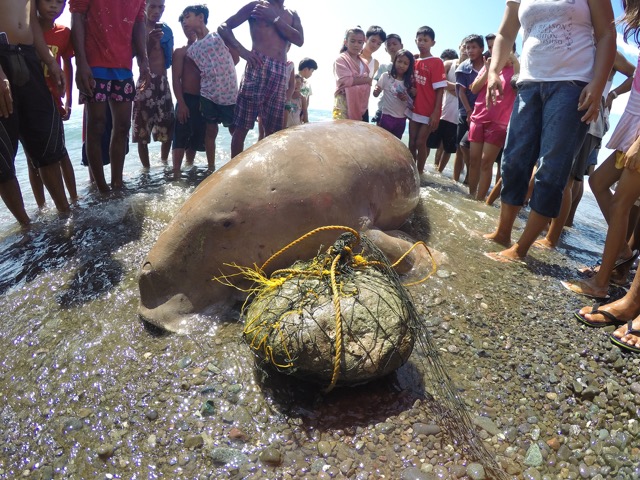
Nery Absalon, a fisherman from Barangay Malabor, saw the floating mammal, and asked the help of the two fishermen Ian Estefaio and Jcar Namion from the village to drag the mammal to shore. Flord Nicson Calawag/Inquirer Visayas
TIBIAO, Antique—A fisherman found an eight-foot, 350-kilogram dugong near the coastline of Tibiao town, Antique province on Friday.
Nery Absalon, a fisherman from Barangay Malabor, saw the floating dead mammal, and asked the help of the two fishermen Ian Estefaio and Jcar Namion from the village to drag it to shore.
“This is the first time that a dugong was caught in Malabor,” said Noel Julian, the barangay (village) captain.
The dugong (Dugong dugon), commonly known as sea cows, lives in shallow coastal waters of the Indian and western Pacific Oceans. It is the only strictly marine herbivorous mammal.
It is a grey brown bulbous animal with a flattened fluked tail, has no dorsal fins, with paddle-like flippers and a distinctive head shape.
Considered vulnerable by the International Union for Conservation of Nature (IUCN) Red List Status, the dugong is the first marine mammal to be protected in the Philippines, although monitoring this is difficult.
Dugongs graze on underwater grasses day and night and can only stay underwater for six minutes before surfacing. They sometimes breathe by “standing” on their tail with their heads above water.
“The sinker tied to the tail of the dugong and the two 4-inch wounds in its belly and forelimb or flipper implies that the mammal was killed,”said Mario Malabor, an agricultural technologist on fisheries in Tibiao.
The fishermen and fish brokers in the village suspected that a “lantip” or a wide-bladed knife was used in slicing the belly and forelimb or flipper of the mammal.
The mammal was sent to the police station in town for blotter report.
Chief Police Inspector Belinda Martinez of Tibiao believes that “it was intentionally done so that the fish would not float.”
“The big rock wrapped with a net which was used as a sinker is not commonly found in Tibiao. This means that the culprit of the dugong is from the other place and was only washed ashore,” said Gil Bandoja, municipal mayor of Tibiao.
Community Environment and Natural Resources Office (CENRO) Culasi examined the carcass and collected the sinker used to kill the mammal.
UPV Museum of Natural Sciences is conducting taxidermy for the dugong. TVJ